Ancient Irish Rituals for Health and Prosperity: Unveiling Timeless Traditions
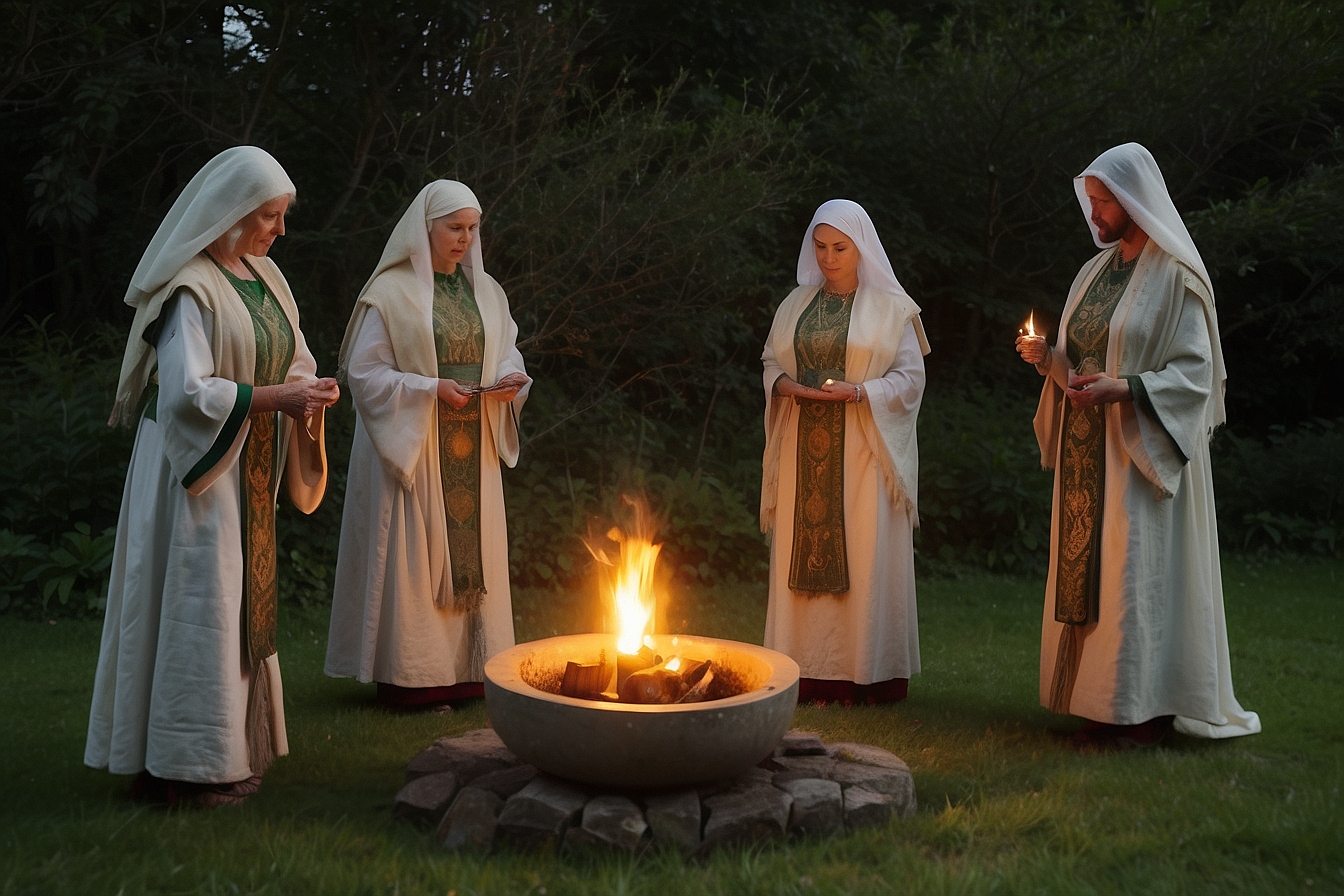
Updated On: April 28, 2024 by Shaimaa Olwan
Ancient Irish rituals for health and prosperity have long been revered for their intrinsic connection to health and prosperity. Ingrained in the fabric of traditional Irish culture, these practices stem from a deep respect for nature and the belief in the power of the elements. From the sacred druid ceremonies to the rituals of the common folk, every action and incantation was performed with a profound sense of purpose, aimed at securing wellbeing and abundance for individuals and the community. These rites were not only spiritual in nature but were deeply rooted in the observances of daily life, agricultural cycles, and key life events.
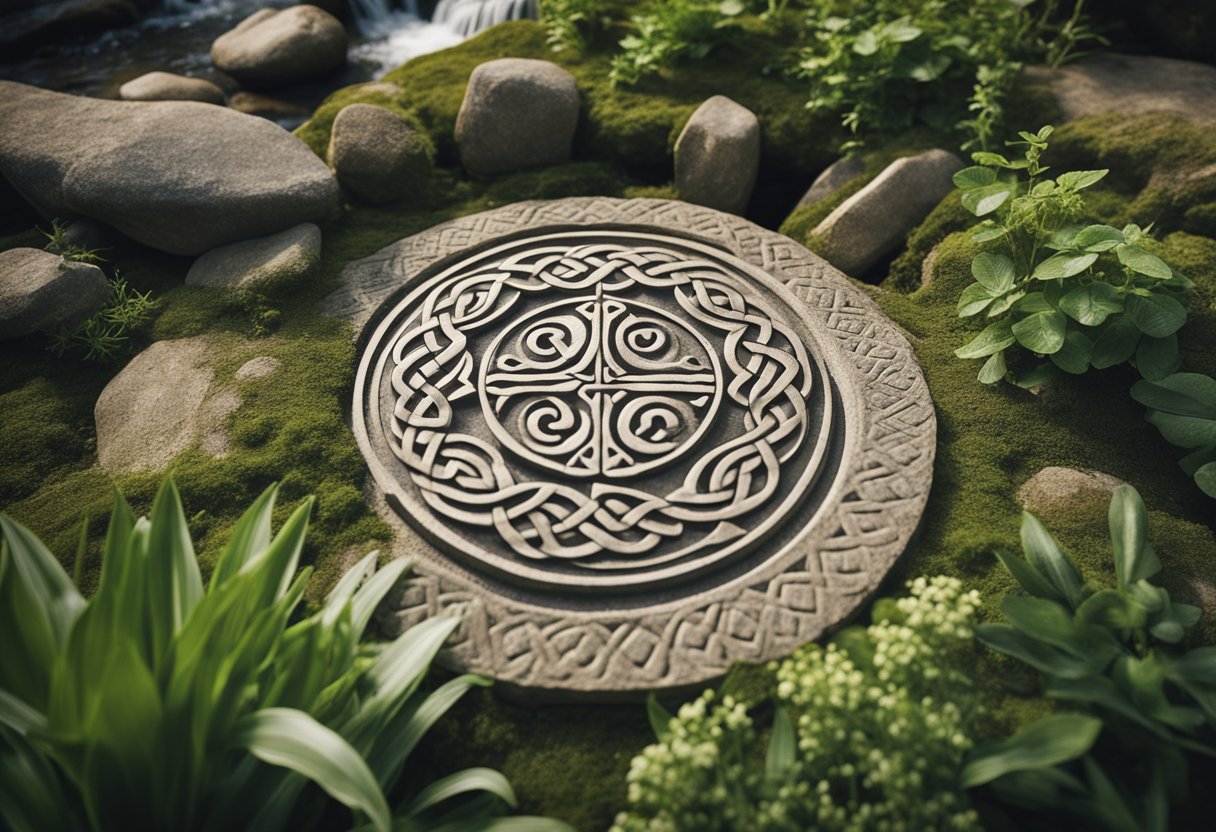
The healing practices of the Celts are particularly notable, woven into a complex tapestry that includes natural elements like water, herbs, and stones. These elements were utilised in a variety of rituals, from protective charms to maintain good health to purifying ceremonies which sought to clear negative influences. Irish folklore is rich with tales of ritual spaces across the land, each revered for its unique power to bestow wellness and good fortune upon those who honoured its sacredness. As these ancient rites are increasingly explored and understood, they continue to shape the narrative of Ireland’s spiritual legacy, offering insights not only into the customs of the past but also into the modern adaptations that keep these traditions alive today.
Table of Contents
Underlying Beliefs and Origins
Exploring the ancient Irish rituals for health and prosperity uncovers a world where spiritual, religious, and natural elements interweave. These practices, rooted in a deep cultural and spiritual landscape, have been passed down through generations, illustrating the historical connection between the people and their land.
Celtic Influence on Ritual Practices
The Celtic world played a crucial role in shaping the rituals and traditions observed in Ireland. Celtic societies were deeply connected to nature, venerating sacred spaces such as springs, rivers, and groves. These places served as conduits for spiritual energy and were often the settings for healing practices and ceremonies aimed at bringing about well-being and prosperity. The legacy of these Celtic influences is evident in the folk medicine and rituals that survived through the ages.
Religious and Spiritual Context
In ancient Ireland, druids and priests were highly esteemed as both scholars and spiritual leaders. They orchestrated complex rituals and had a comprehensive understanding of the medicinal properties of local plants and herbs. The religious context of these practices was grounded in the belief that health and prosperity were blessings to be sought from the gods through both prayer and tangible offerings. From invoking protection against illnesses to celebrating the cycles of nature, the spiritual and religious fabric of Ireland gave rise to a rich tapestry of rites and customs.
Key Elements of Rituals
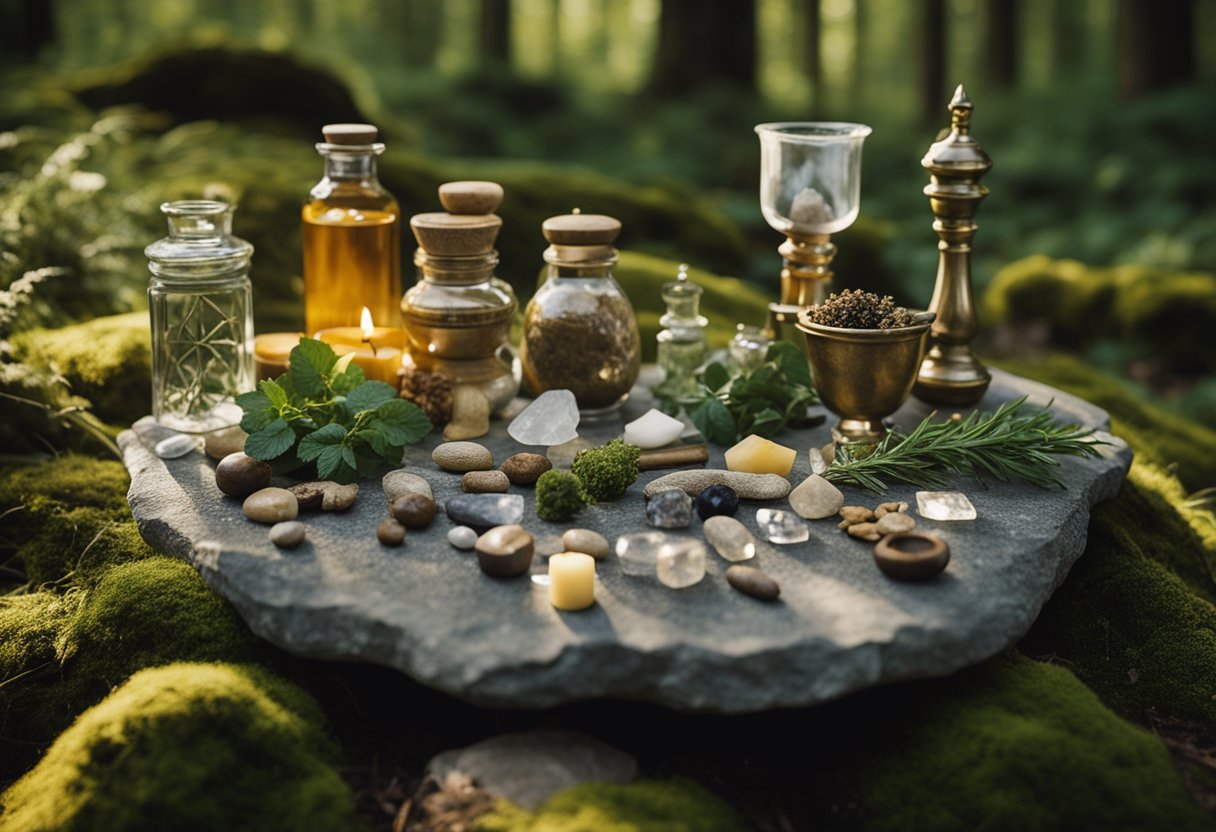
In exploring the sacred customs of ancient Ireland, we encounter specific elements that were integral to rituals conducted for health and prosperity.
Use of Natural Elements
Ancient Irish rituals frequently employed natural elements, with water and land being particularly significant. Springs and holy wells were deemed sources of healing power, where people would come to pray for health. These wells often had specific rituals associated with them, like circling the well a certain number of times or leaving offerings. The sea, known for its vastness and mystery, also played a role in rituals, embodying the power and strength of nature.
Role of Incantations and Prayers
Incantations and prayers were central to invoking the desired outcome of rituals. Spoken words were believed to hold great power and were often recited to harness the energy of the natural world. Herbs played a significant role in these rituals, as different plants were attributed various properties that could influence health and wellbeing.
Involvement of Sacred Spaces
Rituals were commonly anchored in sacred spaces such as stone circles, ancient groves, or significant landmarks connected to Irish mythology. The energies of these places were thought to amplify the effects of the rituals being performed, making them pivotal to the desired outcomes. Through engaging with the land itself, participants were connecting with the inherent power thought to reside there.
By understanding these components, we gain insight into the reverence of nature and the elaborate practices of our ancestors in their pursuit of health and prosperity.
Rituals for Physical and Mental Well-being
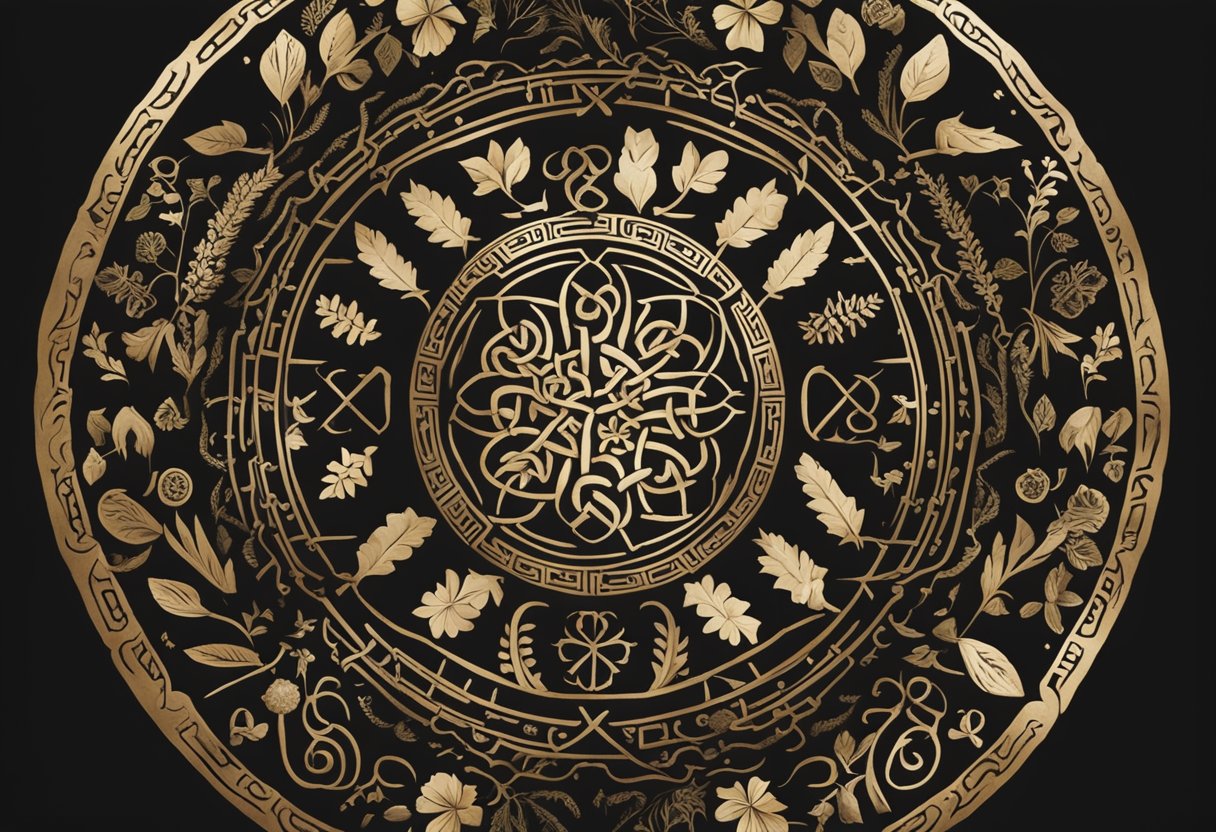
In our exploration of ancient Irish rituals, we focus on practices that promote physical health and mental equilibrium. Irish history is rich with techniques centred on healing and maintaining good health.
Healing Techniques
Historically, Celtic healers utilised a variety of modalities to treat illness. Among these were:
- Water: Revered as a purifying element, water from sacred wells was often used in healing rituals.
- Stone: Certain stones were believed to possess curative properties and were applied in treatments for various ailments.
- Fire: Fire, symbolising life and purity, was used in ceremonies to promote healing and protection.
Learn about the interconnection of these practices at Four Directions Wellness.
Herbal Remedies
Our ancestors knew the land and its offerings well. They combined herbs to create potent remedies for both physical and mental conditions, such as:
- Yarrow: Known for its wound-healing properties.
- Nettle: Used to alleviate pain and support general health.
The wisdom of these herbal concoctions reflects a deep understanding of natural medicine.
Spiritual Cleansing
Emotional and spiritual well-being were also vital to our forebears. They practised:
- Symbolic rituals: These included cleansing spaces of negative energies, often through smoke or fire rituals.
- Storytelling: By sharing stories, people sought to heal the spirit and pass down knowledge of healing and emotional resilience.
Acknowledging the changing seasons and cycles of life, like on Imbolc, was intrinsic to maintaining harmony and good health.
Our rich cultural tapestry weaves together these ancient practices, reminding us of the holistic approach our predecessors took towards health and well-being.
Seasonal and Agricultural Rituals
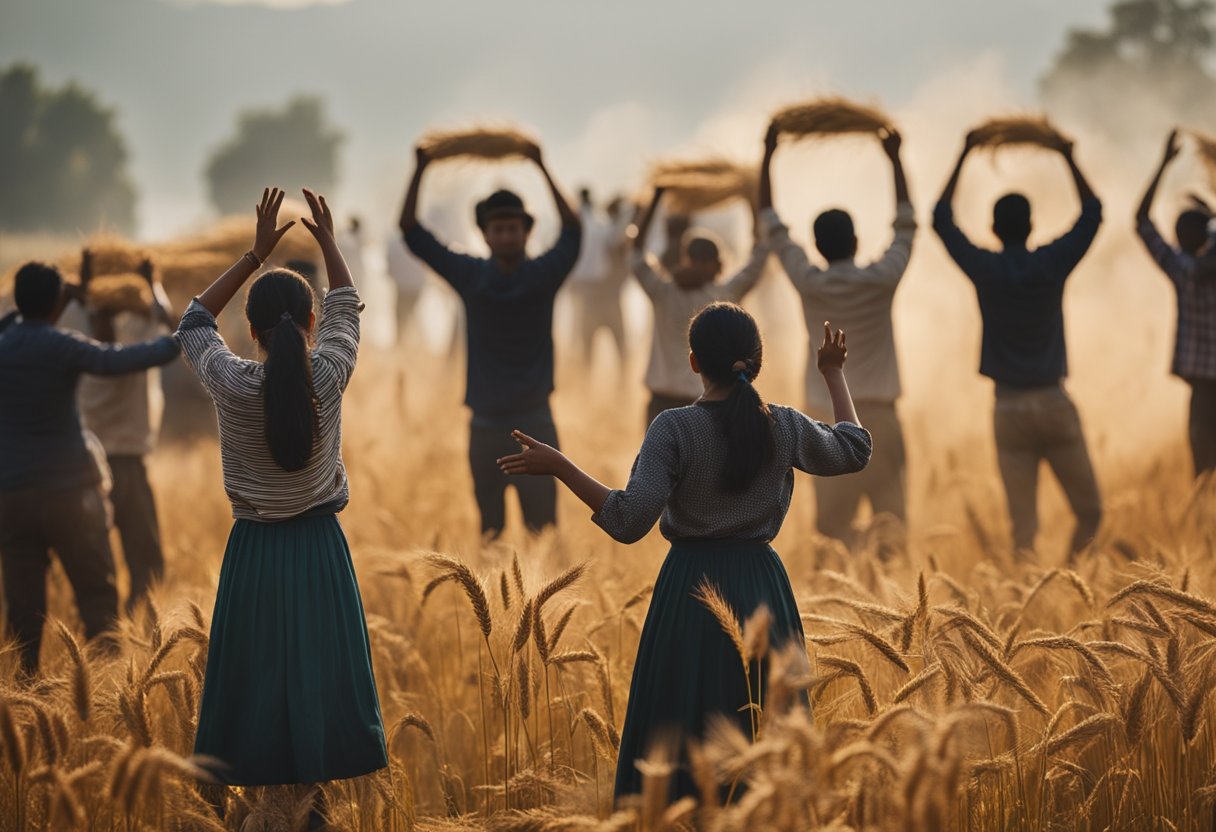
In Ireland, the passage of seasons and agricultural practices were deeply intertwined with rituals aimed at ensuring fertility and prosperity. Our ancestors observed the land’s natural cycles, marking these with festivals and rites that helped sustain both their livelihood and cultural heritage.
Festivals and Fertility Rites
The Celtic calendar included several festivals imbued with rituals to promote fertility and health. Imbolc celebrated on 1 February, honoured the goddess Brigid, symbolising the beginning of spring and the lactation of the ewes. May Day, or Bealtaine, heralded the start of summer, featuring bonfires to protect the community and encourage the growth of crops and livestock. Lughnasadh, on 1 August, celebrated the start of the harvest season, focusing on the god Lugh’s skills as patron of crafts and trade. Lastly, Samhain on 1 November marked the end of the harvest and the beginning of winter.
- Imbolc: Spring Commencement, Ewe’s Milk
- Bealtaine: Summer Start, Crops & Livestock Protection
- Lughnasadh: Harvest Begin, Crafts & Trade
- Samhain: Winter Introduction, Harvest End
Harvest and Land Blessings
During the harvest, rituals were central to giving thanks and ensuring the continuous fertility of the land. Druids were believed to bless the fields, and people would enact sacrifices – sometimes symbolically – to appease deities. Gifts of the first sheaf of grain, the protection of crops, and the well-being of both people and livestock were pivotal concerns. These practices were {not only} religious but practical as well, ensuring the community took stock of its sustenance and prepared for the seasons ahead. The successful harvest was also a boon for trade, as surplus could be exchanged for goods from other regions.
- Field Blessings: Invoking Deity Favour
- Harvest Sacrifices: Ensuring Continuity of Resources
- First Sheaf Gifts: Gratitude for Abundance
Rites of Passage
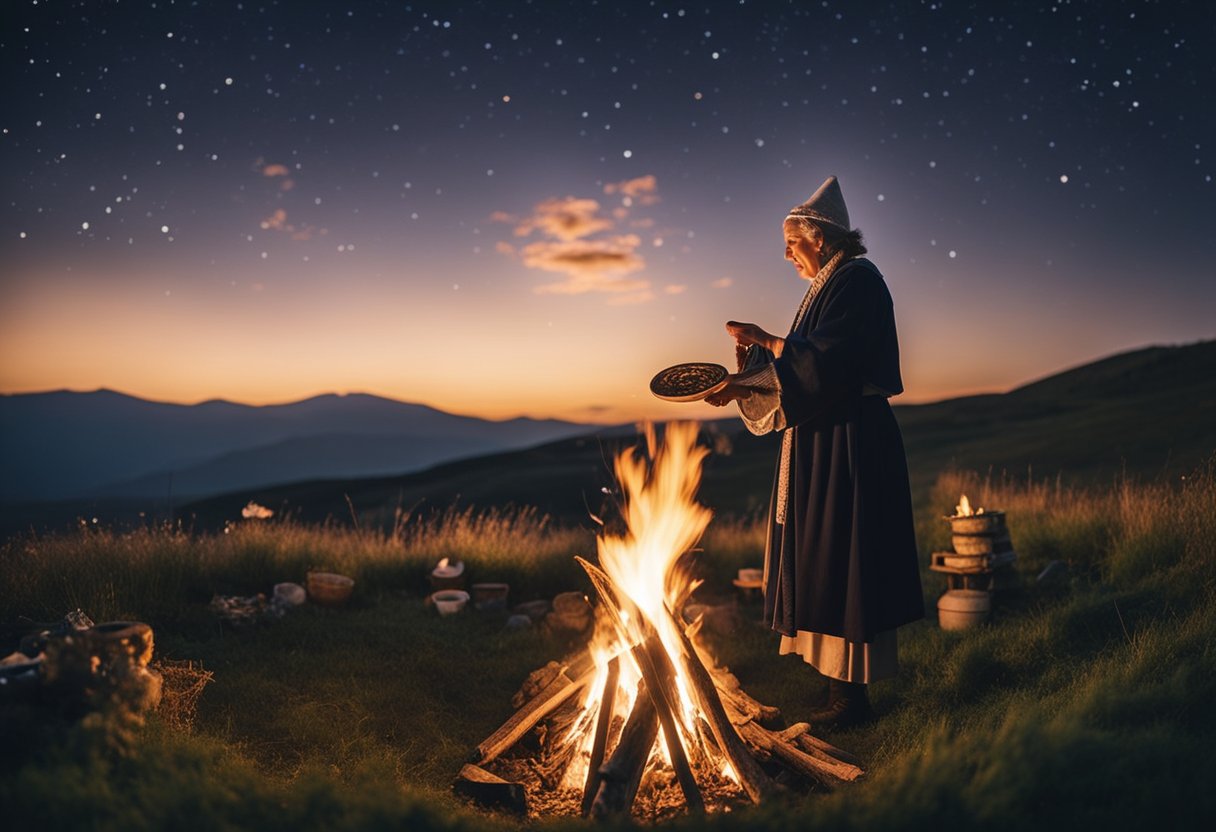
In Irish tradition, rites of passage have long been deeply ingrained in the fabric of society, marking the significant transitions in an individual’s journey through life. These customs not only honour the individuals but also reinforce the bonds within the community and acknowledge the influential role of ancestors.
Birth and Naming Ceremonies
The arrival of a new member into the community begins with birth ceremonies, where the naming of the child connects them to their ancestors and the wider society. These rituals include baptisms, which a majority of individuals in Ireland incorporate into their faith practices, particularly within the Catholic tradition. This initial ceremony sets the infant on their life’s journey, enveloped by the cultural and spiritual values of their community.
Initiation and Marriage Rituals
As children grow, they transition through various life stages, and initiation rituals pave the way to adulthood. These ceremonies often revolve around education and societal roles. Marriage is another pivotal rite, symbolising the union of two individuals and their families. The wedding customs weave together both the personal commitment and the community’s blessing, solidifying the couple’s place in the societal fabric.
Death and Ancestral Veneration
The final passage is one that honours a person’s death, a moment when society collectively remembers and celebrates their life. Irish funeral rites often take place in a graveyard, where the community can pay respects. These practices ensure that the connection to the ancestors remains strong and that the departed individual’s legacy continues on through memory and remembrance.
Protective and Purification Practices
In ancient Ireland, maintaining well-being and fending off misfortune were essential aspects of daily life. This involved specific rituals to shield from harm and to purify one’s surroundings.
Warding Off Evil
Charms and incantations: We have long employed a range of powerful charms and spoken incantations to protect ourselves from evil influences. These practices were profound in their simplicity yet believed to be potent against malevolent forces.
- Combating the Evil Eye*: It was widely held that the Evil Eye could bring about misfortune. To counteract its effects, we would often use protective amulets or recite specific words meant to deflect this negative enfeeblement.
Cleansing Spaces and Objects
Using candles and herbs: Cleared our homes and sacred spaces of negative energy effectively and regularly. The ancient act of lighting candles, often accompanied by specific prayers or blessings, was to cast out darkness both physically and spiritually.
- Purification rituals*: Various objects, from tools to personal belongings, were cleansed through rituals to maintain their sanctity and effectiveness. Whether through smoke purification or the anointment with blessed water, these objects received meticulous attention to ensure they remained sanctified and pure.
Witches were, at times, consulted for their knowledge of natural substances and their uses in protective and purification rituals. By making use of specially concocted potions or specific rituals, they contributed to the safeguarding of individuals and communities from harm.
Rituals in Folk Medicine
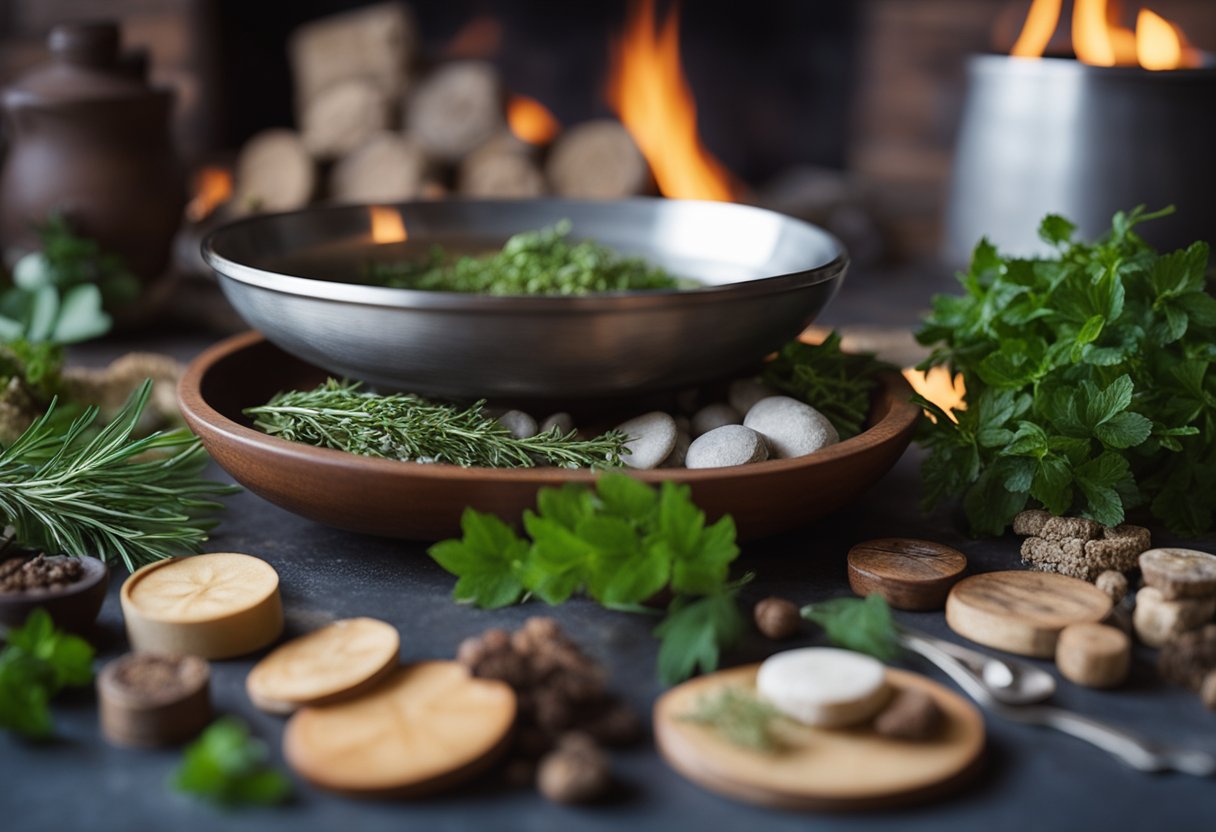
In ancient Ireland, maintaining health and warding off diseases heavily relied on rituals in folk medicine, merging botanical knowledge with spiritual beliefs. We observe a myriad of treatments rooted in the natural environment and the wisdom passed down through generations.
Common Ailments and Herbal Cures
Ireland’s rich flora provided a variety of plants, such as nettles and yarrow for addressing common ailments.
- Nettles: Used to relieve pain from arthritis and to purify the blood.
- Yarrow: Applied for healing wounds, and its ingestion helped alleviate digestive issues.
These plants were integral to herbal cures, concocted with precision and care, often accompanied by specific rites that aimed to harness their full healing potential.
Traditional Healers and Their Methods
Traditional healers sometimes referred to as wise women or cunning folk, possessed a deep understanding of remedies and potions. Their methods encompassed:
- Creating potions: Mixtures brewed for various afflictions, emphasising the spiritual connection between the healer and the natural world.
- Healing rituals: Not only the physical act but also the ceremonial aspect was pivotal in the healing process.
The healers’ knowledge, while largely practical, was steeped in the belief that health and prosperity were interconnected, with these rituals often forming the crux of folk medicine practices.
Sacred Objects and Symbolism
In ancient Irish traditions, specific objects and symbols held powerful meanings and were integral to rituals seeking health and prosperity. Their significance was deeply rooted in the spiritual and physical realms.
Significance of Iron and Stone
In the ancient Celtic world, iron was revered for its strength and was often fashioned into weapons that bore symbolic inscriptions and designs. These items weren’t merely tools of warfare; they represented protection and the ability to overcome adversity. Stones, especially standing stones and dolmens,** served as timeless witnesses to sacred ceremonies, believed to be imbued with the energies of the earth itself. Such stones could mark sacred spaces or act as offerings and focal points in rituals aiming to secure well-being and fortune.
Amulets and Talismans
Amulets and talismans crafted from metals, stones, and organic materials like wood and bone were commonly worn or carried by individuals in ancient Ireland. Each piece embodied a specific symbolic meaning or power. The Dara Knot, for instance, is a symbol derived from the Irish word for oak tree, ‘Doire’, signifying strength, stability, and wisdom. Amulets, like the 15 Celtic Symbols and Meanings (An Irishman’s 2024 Guide), carried spiritual significance that connected the physical and mystical realms, offering protection, health, and a path to prosperity for those who bore them. These items were often intricately decorated with knotwork and other motifs, which not only served an aesthetic function but also imbued the items with layers of spiritual significance.
Objects such as the cauldron were not merely domestic utensils but also powerful symbols of abundance and regeneration. In myth and ritual, the cauldron was often associated with the gods and was a central element in tales and practices around rejuvenation and bounty, influencing events for betterment.
In our examinations, we discover that such jewellery items and symbolic artefacts were not only decorative but were embedded with meanings, acting as a bridge between the tangible world and the ethereal forces that governed health and fortune.
Ritual Spaces Across Ireland
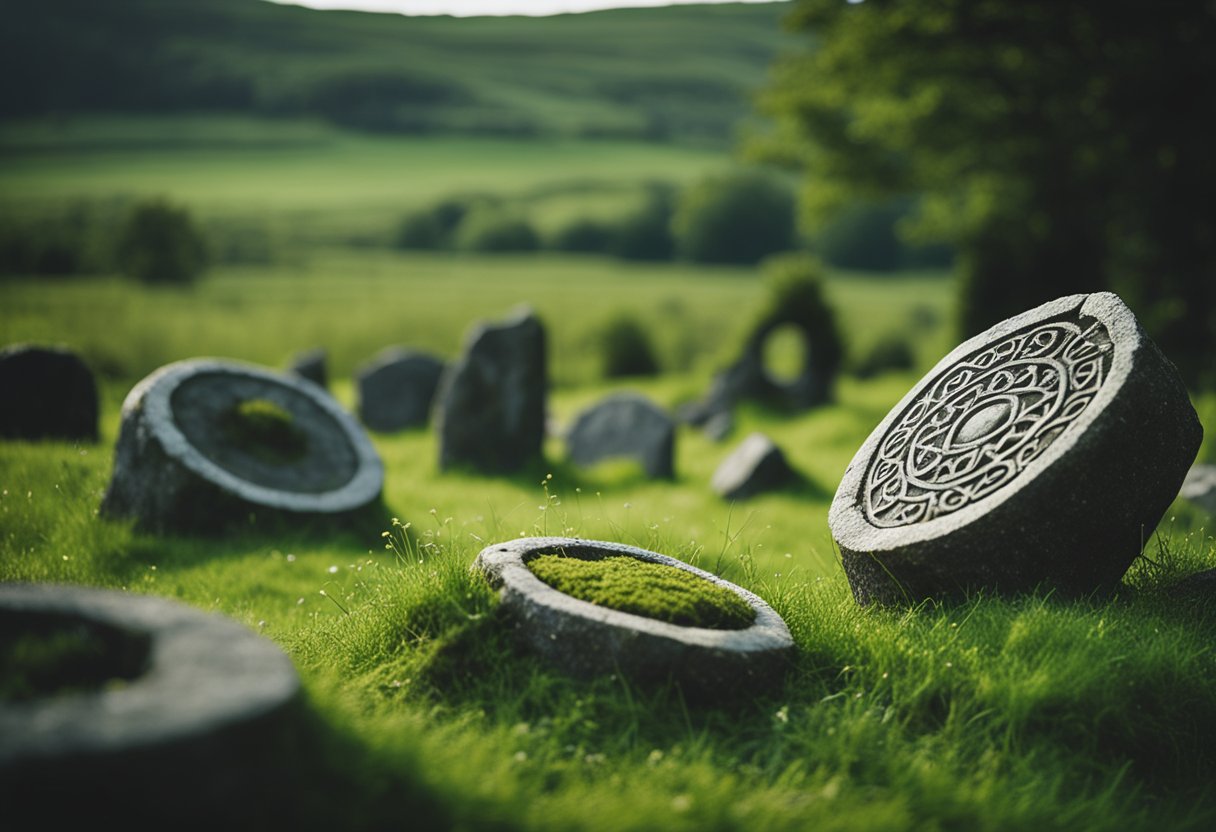
As we explore the rich tapestry of Ireland’s ancient past, we find the landscape dotted with sacred sites used for rituals aimed at health and prosperity. These spaces, some constructed and others part of the natural land, bear witness to the country’s deep spiritual heritage.
Prominent Holy Sites
In the North, the significance of religious locales such as churchyards mirrors Ireland’s respect for sacred land. Ulster boasts a number of these sites, where the ancients performed health-related rituals. The South and East of Ireland are no different, with each region offering a unique array of holy sites that have served local communities for centuries, reflecting their enduring spiritual importance.
Natural Springs and Wells
Moving from the prominent constructed sacred spaces, Ireland’s natural springs and wells, especially those around the seaside, are historically revered across the land for their curative properties. Referenced in various annals, these holy wells are traditionally encircled by a distinct sense of reverence, and rituals practised here often involve the usage of water as a conduit for health and well-being. The West of Ireland, in particular, is home to a number of these wells, each steeped in local legend and lore, drawing visitors who seek both physical and spiritual refreshment.
Preservation of Ancient Rituals
We understand the importance of safeguarding the traditional practices that have shaped Irish culture through the ages. From music and dance to writing and artefacts, preserving these ancient rituals ensures that the wisdom and beauty of our ancestors continue to enrich society.
Oral Tradition and Storytelling
Storytelling, enshrined through oral tradition, is a cornerstone of ancient Irish rituals. It serves as a living archive, passing down the intricacies of our traditions and the nuances of our culture. Through vivid narratives and music, every generation inherits a rich tapestry of communal knowledge and ancestral wisdom, breathing life into age-old customs across Europe. Furthermore, this oral transmission is instrumental in sustaining our societal values and ritual preservation.
Artefacts and Archaeological Finds
Archaeological findings substantiate the practice of our forebears’ rituals. Artefacts such as the stone adze uncovered in Ireland’s earliest known human burial illustrate our ancestors’ beliefs about death. Likewise, other discoveries contribute to our comprehension of ancient health and prosperity rituals. These tangible pieces of history serve as essential tools in reconstructing and preserving our heritage, allowing us to celebrate and continue traditions that have been part of our society for millennia.
Modern Adaptations and Legacy
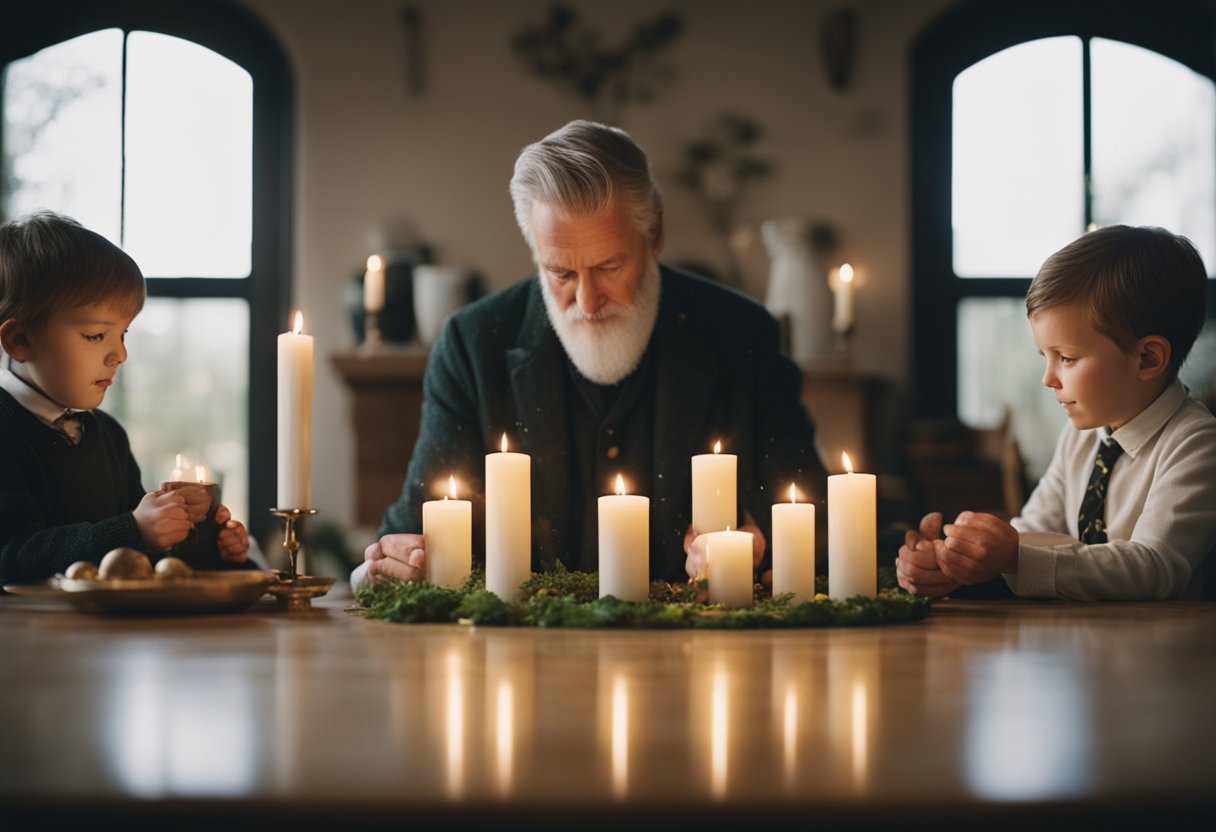
Ancient Irish rituals for health and prosperity have transformed over time, integrating into modern practices and continuing to shape our cultural identity and wellness trends.
Contemporary Practices
Herbal medicine, with its roots deeply entrenched in our Irish ancestors’ knowledge, remains influential. Today, we observe a resurgence in the use of natural remedies, paralleling increased interest in wellness trends. Feng Shui, albeit of Eastern origin, complements these practices and has been adopted by some to harmonise environments, enriching our approach to health and spatial energy. In Ireland, ancient herbal practices are adapted into current wellness regimes, as noted in discussions about Indigenous Narratives of Health.
- Herbal Medicine: Incorporation into modern apothecaries and holistic therapies.
- Feng Shui: Application in creating balanced living spaces for better mental well-being.
Influence on Modern Society
Our ancestors’ legacy pervades much of modern medicine, with ancient wisdom often underpinning contemporary healing techniques. Our cultural identity is bolstered by this enduring heritage, acknowledging Ireland’s historical contribution to health practices. As such, the influence extends beyond individual wellness to societal health paradigms. Moreover, the evolution of traditions can be seen to enrich modern literature, as mentioned in analyses of New Uses of Traditional Healing in Contemporary Irish Literature.
- Cultural Identity: Celebrating and revitalising our ancestral knowledge in modern contexts.
- Modern Medicine: Drawing inspiration from historical remedies in current medical approaches.
Frequently Asked Questions
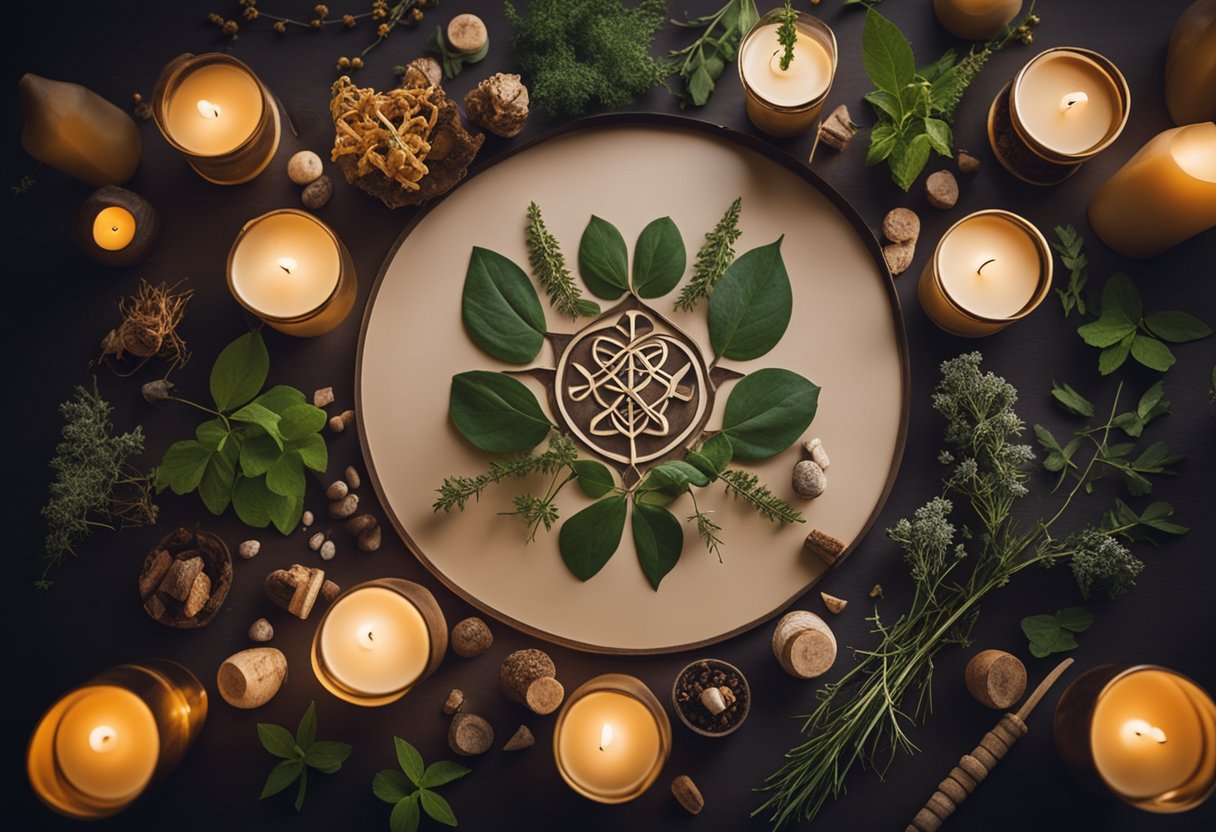
In addressing some of the most intriguing aspects of ancient Irish culture, we touch upon the long-standing rituals for health and good fortune, the use of healing symbols, and the roles played by both folk Catholicism and witchcraft in seeking wellness.
What practices constituted ancient Irish rituals for well-being and good fortune?
Ancient Irish rituals for well-being were deeply intertwined with the natural world and the seasons. Practices such as lighting bonfires during Samhain to protect against evil spirits or using herbal remedies for healing were common. The celebration of Imbolc signified the beginning of spring and involved blessings for fertility and prosperity.
How were Celtic healing symbols utilised in ancient Irish traditions?
Celtic healing symbols like the Triskelion, which represents progress and growth, were carved into stones or incorporated into jewellery. These symbols were believed to harness the power of nature and the universe to promote healing and balance in one’s life.
Can you describe the role of folk Catholicism in Irish health and prosperity ceremonies?
Folk Catholicism in Ireland blended pre-Christian beliefs with Catholic practices. Holy wells were often visited for their purported healing properties, and patterns, or pilgrimages, around these wells, were performed for both physical well-being and spiritual merit.
What are the historical roots of Irish folk witchcraft in relation to wellness rituals?
The roots of Irish folk witchcraft are found in ancient Pagan traditions and later influenced by Christian elements. Herbs, charms, and spells were commonly used to protect health, cure illness, and ensure prosperity. Knowledge of healing plants and methods to use them was often passed down through generations.
Who were recognised as healers in ancient Irish society, and what methods did they employ?
Healers, often referred to as wise women or men, were crucial in ancient Irish society. They relied on an extensive knowledge of herbal remedies, incantations, and the power of the elements to treat illness. They were also known to conduct rituals to safeguard against spiritual harm.
What is known about the sacred sites associated with healing in Ireland?
Sacred sites, such as the Hill of Tara or the standing stones of Glendalough, were focal points for rituals and were said to be places of potent energy. People would visit these sites for their healing energies, engage in meditation, and perform ceremonies, believing in the land’s inherent power to restore health.






